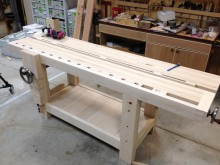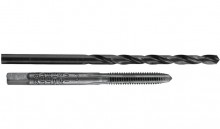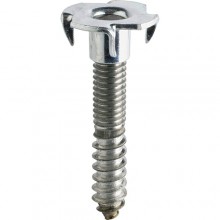167 – Tapping Threads in Wood
Video - February 24, 2012
 During the construction of my Split-Top Roubo Workbench (which is nearing completion), I was surprised to see Benchcrafted’s plans calling for numerous tapped threads. Instead of attaching the various components of the leg vise using screws or bolts with nuts, they actually recommend cutting threads into the wood! I certainly understood the concept of tapping threads, but I never really considered applying it to woodworking. After picking up some taps and cutting a few myself, I am now a convert! I can just imagine the possibilites in the world of jig-building alone!
During the construction of my Split-Top Roubo Workbench (which is nearing completion), I was surprised to see Benchcrafted’s plans calling for numerous tapped threads. Instead of attaching the various components of the leg vise using screws or bolts with nuts, they actually recommend cutting threads into the wood! I certainly understood the concept of tapping threads, but I never really considered applying it to woodworking. After picking up some taps and cutting a few myself, I am now a convert! I can just imagine the possibilites in the world of jig-building alone!
Before learning to tap threads in wood, I thought it would be helpful to review other types of mechanical fasteners and why they might not be as good as a bolt in a threaded hole.
Nails
Nails are pretty much a brute-force way of holding things together. The nail is driven into the wood, splitting and compressing fibers the whole way. Over time, natural forces cause the wood around the nail to compress even further eventually leading to joint failure.
Screws
A step up from a nail is the screw. When you rotate the screw into the wood, it pulls itself in and threads itself into the fibers. The good thing about screws is they are removable, but over the course of years the cut threads become wider and wider and the screw will eventually loosen up.
Threaded Bolts
This is the star of our show today. Once the threads are cut into the wood, you can pretty much remove and replace the bolt as many times as you want and it really doesn’t do any damage to the wood. This is because the bolts threads are sized perfectly to fit into the threads that are cut into the wood. So this is perfect for applications where you may need to loosen and tighten components on a routine basis.
Tapping Threads
 All you need to make a threaded hole is a drill bit and a tap. The drill has to be a very specific size and and you can typically find drills and taps in matched sets such as this one. If you need help matching up your bolt, drill, and tap, refer to the handy charts on this page.
All you need to make a threaded hole is a drill bit and a tap. The drill has to be a very specific size and and you can typically find drills and taps in matched sets such as this one. If you need help matching up your bolt, drill, and tap, refer to the handy charts on this page.
Here’s how the system works. The drill bit is used to create the perfect size hole. The tap is then driven into the hole cutting the threads on its way down. You have to be very careful not to strip the threads during this part of the process but in a dense hardwood like maple, you should have no trouble at all. While you might be tempted to use a traditional T-handled wrench for this, I found it much easier to use a power drill at a very slow speed.
Tee Nuts
 One alternative that we can’t forget to mention here is the Tee Nut. These little threaded inserts accomplish the same thing as the threaded bolt technique only instead of actually cutting threads, we simply insert a threaded insert into a hole. They are very easy to use but unfortunately, the way they connect to a workpiece leaves a little to be desired. Over time, the small teeth that go into the wood fibers can break or the wood itself can compress, causing the Tee Nut to lose its grip. So while they can get the job done, I don’t really see them as a good long-term solution.
One alternative that we can’t forget to mention here is the Tee Nut. These little threaded inserts accomplish the same thing as the threaded bolt technique only instead of actually cutting threads, we simply insert a threaded insert into a hole. They are very easy to use but unfortunately, the way they connect to a workpiece leaves a little to be desired. Over time, the small teeth that go into the wood fibers can break or the wood itself can compress, causing the Tee Nut to lose its grip. So while they can get the job done, I don’t really see them as a good long-term solution.



